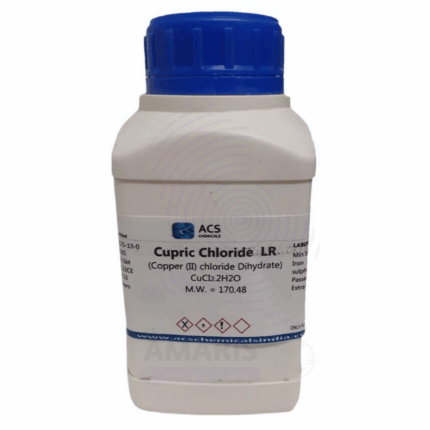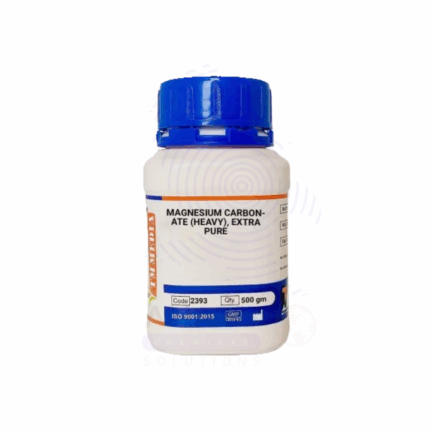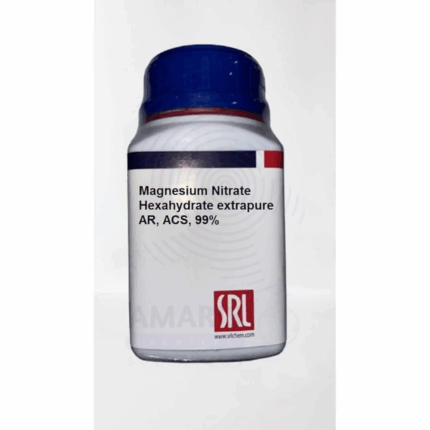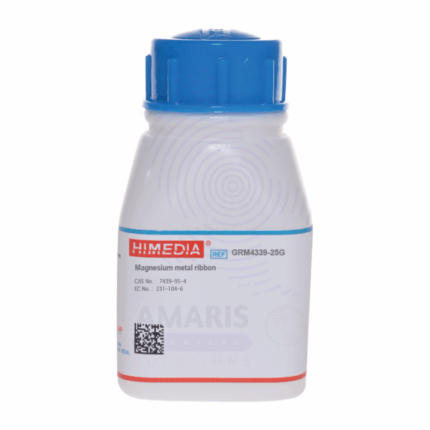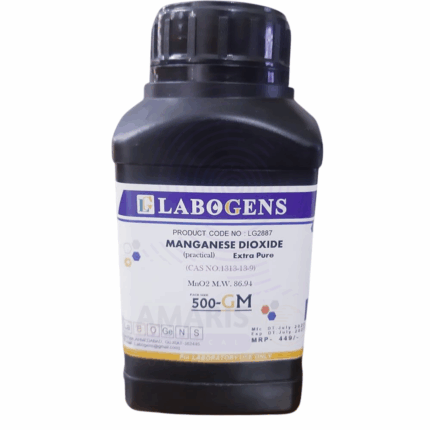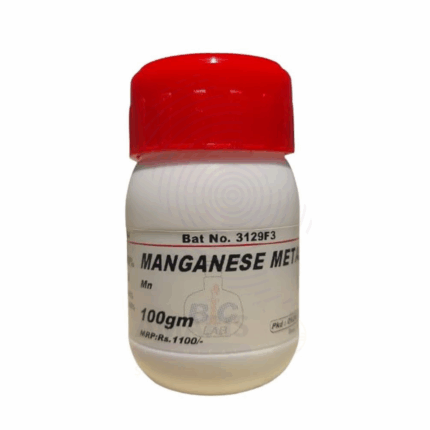



Oxalic Acid Extra Pure
$ 16.00 Original price was: $ 16.00.$ 15.76Current price is: $ 15.76.
Oxalic Acid Extra Pure is a high-purity, crystalline organic compound known for its strong reducing and chelating properties. Appearing as a white, odorless solid, it is highly soluble in water and widely utilized in both laboratory and industrial settings.
This Extra Pure grade ensures reliable performance in analytical chemistry, metal cleaning, rust removal, and rare earth element processing. In the laboratory, it is commonly used to precipitate calcium ions and to prepare standard solutions for titration. In industries, Oxalic Acid is valued for its effectiveness in bleaching wood, cleaning marble, and removing iron stains from surfaces and textiles. Due to its toxicity and corrosiveness, it must be handled with appropriate personal protective equipment and stored securely in a cool, dry, well-ventilated area.
Oxalic Acid Extra Pure
Primary Uses
- Rust and Metal Stain Removal
- Used as a chelating agent to dissolve insoluble iron (III) compounds (rust) by forming a soluble complex ion, iron(III) oxalate. This makes it highly effective in industrial cleaners, automotive rust removers, and for treating metal surfaces prior to painting or coating.
- Bleaching Agent in Textile and Wood Industries
- Employed to bleach natural fibers like cotton and jute in the textile industry. In woodworking, it is used to chemically bleach darkened or stained wood (e.g., water stains on oak) by reducing colored compounds, lightening the wood’s appearance without sanding.
- Cleaning and Sanitizing Agent in Brewing and Dairy Industries
- Effectively removes calcium-based scales and beer stone (calcium oxalate) from fermentation tanks, kettles, and piping in breweries. Similarly, it is used to clean dairy equipment where it dissolves milkstone, a deposit of calcium and magnesium salts.
- Precipitating Agent in Rare Earth Element Processing
- Crucial in hydrometallurgy for the separation and purification of rare earth elements. Oxalic acid precipitates rare earth oxalates from solution, which are then filtered and calcined to produce the corresponding rare earth oxides.
Secondary Uses
- Analytical Chemistry (Volumetric Analysis)
- Serves as a primary standard in redox titrations (particularly in acidified potassium permanganate titrations) due to its high purity, stability, and well-defined reaction stoichiometry for standardizing solutions and determining oxidizing agent concentrations.
- Reactant in Organic Synthesis and Dye Intermediates
- Used as a starting material or catalyst in various organic syntheses, such as the production of certain antibiotics and fine chemicals. It is also involved in the synthesis of dyes and as a mordant in dyeing processes.
- Component in Metal Polishing and Electroplating Solutions
- Added to metal polish formulations for aluminum, brass, and other non-ferrous metals to remove tarnish and restore shine through its chelating and mild acidic action. Used in electroplating baths as a complexing agent to control the deposition rate and quality of the metal coating.
- Decontaminant and Decommissioning Agent in Nuclear Facilities
- Utilized to dissolve and decontaminate radioactive scale (often containing uranium and other radionuclides) from the surfaces of reactor components and piping, facilitating the safe decommissioning of nuclear facilities.
KEY ATTRIBUTES
1. Basic Identification Attributes
- Chemical Name: Oxalic Acid
- CAS Number: 144-62-7
- HS Code: 2917.11.00
- Molecular Formula: C₂H₂O₄ (Anhydrous)
- Synonyms:
- Ethanedioic acid
- Dicarboxylic acid
- Oxalate (conjugate base)
2. Physical & Chemical Properties
- Physical State: Solid (crystalline powder)
- Color & Odor: White; odorless
- Boiling Point: Decomposes before boiling
- Melting Point: ~189–191 °C (decomposes)
- Density: 1.9 g/cm³ (anhydrous)
- Solubility:
- Soluble in water (9.5 g/100 mL at 25 °C)
- Soluble in alcohols
- pH Level: ~1.3 (0.1 M aqueous solution; strongly acidic)
- Vapor Pressure: Negligible
- Flash Point: Not applicable (non-volatile solid)
- Autoignition Temperature: Not flammable under standard conditions
- Viscosity: Not applicable
3. Safety & Hazard Attributes
- Hazard Class (GHS Classification):
- Acute toxicity (oral, dermal) – Category 4
- Skin corrosion/irritation – Category 1B
- Serious eye damage – Category 1
- NFPA Ratings:
- Health: 3
- Flammability: 1
- Reactivity: 1
- Exposure Limits:
- OSHA PEL: 1 mg/m³ (TWA)
- ACGIH TLV: 1 mg/m³ (TWA)
- Reactivity:
- Incompatible with strong oxidizers, bases, and reducing agents
- Can react with metals to produce hydrogen gas
4. Storage & Handling Attributes
- Storage Conditions:
- Store in tightly closed containers
- Keep in cool, dry, well-ventilated area
- Incompatible Materials:
- Strong bases, oxidizers, sodium hypochlorite, nitric acid
- Container Type: Plastic or corrosion-resistant glass
- Shelf Life & Expiration Date: Stable for 2–3 years under recommended conditions
- Special Handling Requirements:
- Use gloves, safety goggles, lab coat
- Handle in a fume hood to avoid inhalation
5. Regulatory & Compliance Attributes
- Regulatory Status:
- Listed in REACH, TSCA, and other major regulatory databases
- Controlled under workplace exposure laws
- Hazard Symbols (GHS Pictograms):
- Transportation Restrictions:
- UN Number: UN 3261 (Corrosive solid, acidic, organic, n.o.s.)
- Hazard Class: 8
- Waste Disposal Method:
- Dispose of according to local regulations
- Do not release into sewers or environment
6. Environmental & Health Impact
- Ecotoxicity:
- Harmful to aquatic life at high concentrations
- Persistence in Environment: Readily biodegradable
- Carcinogenicity/Mutagenicity:
- Not classified as carcinogenic
- No mutagenic effects reported in standard assays
- Biodegradability: Rapidly biodegradable under aerobic conditions
SAFETY PRECAUTIONS
Personal Protective Equipment (PPE):
- Wear a lab coat, nitrile gloves, and chemical safety goggles.
- Use a dust mask or handle in a well-ventilated area or fume hood.
Handling:
- Avoid contact with skin, eyes, and clothing.
- Prevent inhalation of dust or vapors.
- Wash hands thoroughly after handling.
- Do not mix with strong oxidizers or bases.
Storage:
- Store in a tightly sealed container in a cool, dry, and well-ventilated place.
- Keep away from moisture, heat sources, and incompatible substances such as bases and oxidizing agents.
- Protect from light and humidity.
FIRST AID MEASURES
Inhalation:
- Move the person to fresh air immediately.
- Seek medical attention if symptoms such as coughing or breathing difficulty occur.
Skin Contact:
- Remove contaminated clothing.
- Wash skin thoroughly with soap and water.
- Get medical attention if irritation or burns develop.
Eye Contact:
- Rinse cautiously with water for at least 15 minutes.
- Remove contact lenses if present and easy to do.
- Seek immediate medical attention.
Ingestion:
- Rinse mouth with water.
- Do not induce vomiting.
- Seek immediate medical attention—can be harmful or fatal if


 Preservatives(food)
Preservatives(food) Flavor Enhancers
Flavor Enhancers Acidulants
Acidulants Sweeteners
Sweeteners Antioxidants
Antioxidants Colorants(food)
Colorants(food) Nutraceutical Ingredients (food)
Nutraceutical Ingredients (food) Nutrient Supplements
Nutrient Supplements Emulsifiers
Emulsifiers
 Collectors
Collectors Dust Suppressants
Dust Suppressants Explosives and Blasting Agents
Explosives and Blasting Agents Flocculants and Coagulants
Flocculants and Coagulants Frothers
Frothers Leaching Agents
Leaching Agents pH Modifiers
pH Modifiers Precious Metal Extraction Agents
Precious Metal Extraction Agents
 Antioxidants(plastic)
Antioxidants(plastic) Colorants (Pigments, Dyes)
Colorants (Pigments, Dyes) Fillers and Reinforcements
Fillers and Reinforcements Flame Retardants
Flame Retardants Monomers
Monomers Plasticizers
Plasticizers Polymerization Initiators
Polymerization Initiators Stabilizers (UV, Heat)
Stabilizers (UV, Heat)
 Antifoaming Agents
Antifoaming Agents Chelating Agents
Chelating Agents Coagulants and Flocculants
Coagulants and Flocculants Corrosion Inhibitors
Corrosion Inhibitors Disinfectants and Biocides
Disinfectants and Biocides Oxidizing Agents
Oxidizing Agents pH Adjusters
pH Adjusters Scale Inhibitors( water)
Scale Inhibitors( water)
 Antioxidants(cosmetic)
Antioxidants(cosmetic) Emollients
Emollients Fragrances and Essential Oils
Fragrances and Essential Oils Humectants
Humectants Preservatives
Preservatives Surfactants(cosmetic)
Surfactants(cosmetic) Thickeners
Thickeners UV Filters
UV Filters
 Fertilizers
Fertilizers Soil Conditioners
Soil Conditioners Plant Growth Regulators
Plant Growth Regulators Animal Feed Additives
Animal Feed Additives Biostimulants
Biostimulants Pesticides (Herbicides, Insecticides, Fungicides)
Pesticides (Herbicides, Insecticides, Fungicides)
 Active Pharmaceutical Ingredients (APIs)
Active Pharmaceutical Ingredients (APIs) Excipients
Excipients Solvents(pharmaceutical)
Solvents(pharmaceutical) Antibiotics
Antibiotics Antiseptics and Disinfectants
Antiseptics and Disinfectants Vaccine Adjuvants
Vaccine Adjuvants Nutraceutical Ingredients (pharmaceutical)
Nutraceutical Ingredients (pharmaceutical) Analgesics & Antipyretics
Analgesics & Antipyretics
 Analytical Reagents
Analytical Reagents Solvents(lab)
Solvents(lab) Chromatography Chemicals
Chromatography Chemicals Spectroscopy Reagents
Spectroscopy Reagents microbiology-and-cell-culture-reagents
microbiology-and-cell-culture-reagents Molecular Biology Reagents
Molecular Biology Reagents Biochemical Reagents
Biochemical Reagents Inorganic and Organic Standards
Inorganic and Organic Standards Laboratory Safety Chemicals
Laboratory Safety Chemicals Specialty Laboratory Chemicals(Special Laboratory Equipment)
Specialty Laboratory Chemicals(Special Laboratory Equipment)
 Demulsifiers
Demulsifiers Hydraulic Fracturing Fluids
Hydraulic Fracturing Fluids Scale Inhibitors(oil)
Scale Inhibitors(oil) Surfactants(oil)
Surfactants(oil) Drilling Fluids
Drilling Fluids
 Dyes and Pigments
Dyes and Pigments Bleaching Agents
Bleaching Agents Softening Agents
Softening Agents Finishing Agents
Finishing Agents Antistatic Agents
Antistatic Agents
 Admixtures
Admixtures Waterproofing Agents
Waterproofing Agents Sealants and Adhesives
Sealants and Adhesives Curing Compounds
Curing Compounds Concrete Repair Chemicals
Concrete Repair Chemicals Anti-Corrosion Coatings
Anti-Corrosion Coatings
 Surfactants(cleaning)
Surfactants(cleaning) Builders
Builders Enzymes
Enzymes Solvents (Cleaning)
Solvents (Cleaning) Fragrances
Fragrances
 Electronic Chemicals
Electronic Chemicals Catalysts
Catalysts Lubricants
Lubricants Photographic Chemicals
Photographic Chemicals Refrigerants
Refrigerants Automotive chemicals
Automotive chemicals Pyrotechnic Chemicals
Pyrotechnic Chemicals
 Biodegradable Surfactants
Biodegradable Surfactants Bio-based Solvents
Bio-based Solvents Renewable Polymers
Renewable Polymers Carbon Capture Chemicals
Carbon Capture Chemicals Wastewater Treatment Chemicals
Wastewater Treatment Chemicals
 Pigments
Pigments Solvents(paint)
Solvents(paint) Specialty Coatings
Specialty Coatings Binders/Resins
Binders/Resins Additives
Additives Driers
Driers Anti-Corrosion Agents
Anti-Corrosion Agents Functional Coatings
Functional Coatings Application-Specific Coatings
Application-Specific Coatings
 Fresh Herbs
Fresh Herbs Ground Spices
Ground Spices Whole Spices
Whole Spices Spice Blends
Spice Blends Dried Herbs
Dried Herbs
 Leavening Agents
Leavening Agents Dough Conditioners
Dough Conditioners Flour Treatments
Flour Treatments Fat Replacers
Fat Replacers Decoratives
Decoratives Preservatives(baking)
Preservatives(baking)
 Plasticizers & Softeners
Plasticizers & Softeners Reinforcing Agents
Reinforcing Agents Adhesion Promoters
Adhesion Promoters Vulcanizing Agents
Vulcanizing Agents Antidegradants
Antidegradants Blowing Agents
Blowing Agents Fillers & Extenders
Fillers & Extenders Accelerators & Retarders
Accelerators & Retarders



